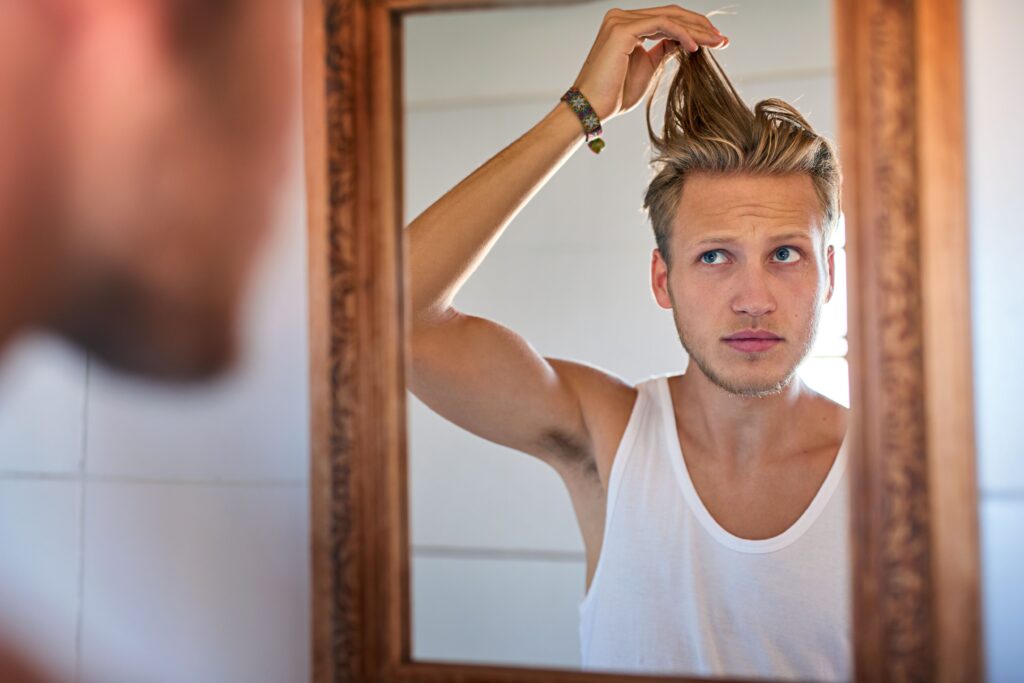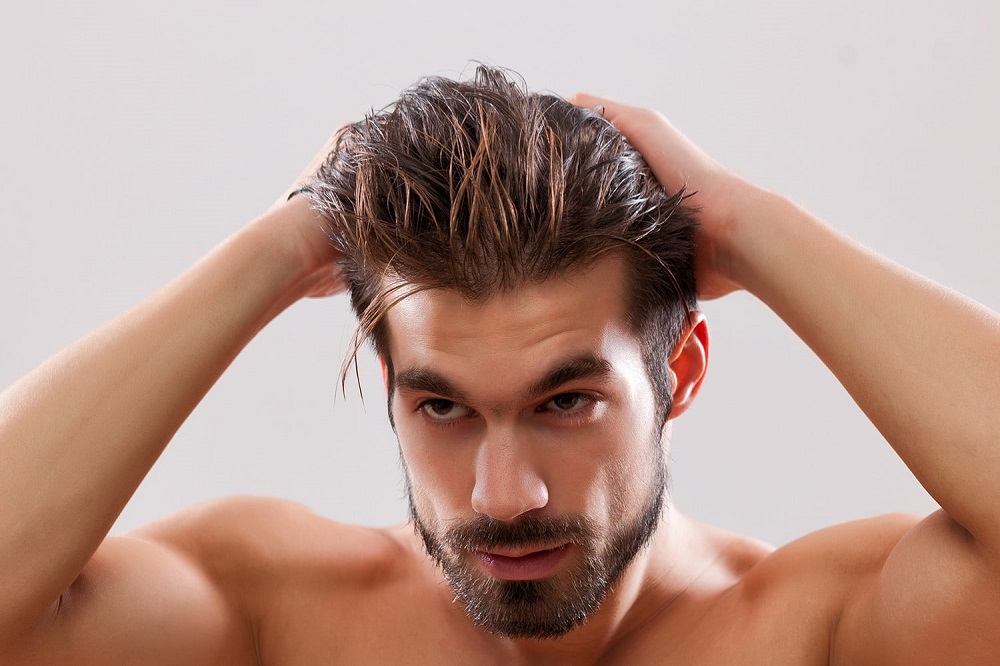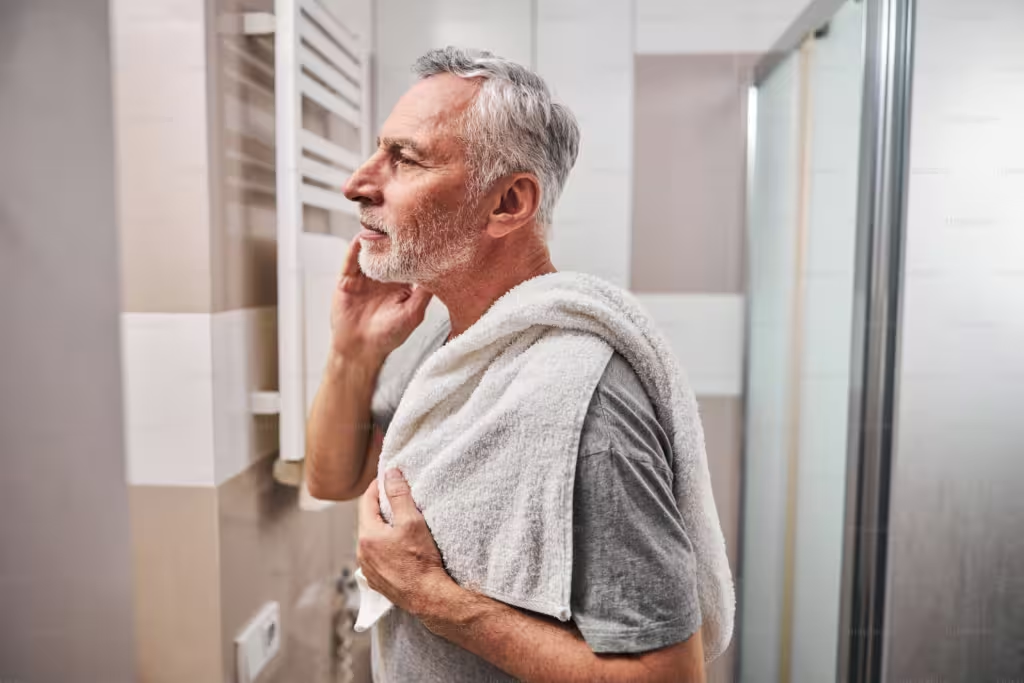Hey guys, let’s talk about hair care. It can feel like a minefield, right? But don’t worry, we’ve got your back. One of the men’s most common questions is whether their hair is dry or oily. Knowing the answer can make a huge difference in choosing the right products and routines. In this post, we’ll dive into the telltale signs of dry hair and oily hair. You’ll be able to better understand and care for your mane quickly.

Dry hair is a common concern for many men. It can show up in different ways. Here are some key signs that your hair might be on the dry side:
1. Dull Appearance: Healthy hair should have a natural shine. If your hair looks dull and lackluster, it’s likely a sign of dryness.
2. Brittle and Prone to Breakage: Dry hair is often brittle. It breaks easily, leading to split ends and a frizzy, unmanageable texture.
3. Tangles and Knots: When hair is dry, it tends to tangle and knot more easily. This can make it tough to comb or style.
4. Rough Texture: Instead of feeling soft and smooth, dry hair often feels rough and coarse. It’s not pleasant to touch.
5. Excessive Flyaways: If you notice a lot of flyaways and static, it could be a sign that your hair needs moisture.
6. Slow Hair Growth: Dry hair can lead to slower hair growth. Lack of moisture weakens the hair follicles and makes it harder for hair to grow.

On the other hand, oily hair comes with its own set of challenges. Here are some signs that your hair might be producing too much oil:
1. Greasy Appearance: Oily hair often looks greasy and shiny, especially around the scalp and hairline. It can appear flat and weighed down.
2. Limp and Lifeless: Excess oil can make your hair look limp and lifeless. It lacks volume and bounce.
3. Frequent Need to Wash: If your hair feels greasy just a day or two after washing, it’s likely due to excess oil production.
4. Visible Oil on Pillowcases: When you wake up, do you see oil stains on your pillowcase? That’s a clear sign of oily hair.
5. Acne or Clogged Pores: Too much oil from your scalp can clog pores on your forehead and face. This can lead to breakouts and acne.
6. Heavy Product Build-Up: Oily hair can cause products to build up more quickly. This leads to a dull, greasy look and potential scalp irritation.
Finding the Right Balance
Once you’ve figured out if your hair is dry or oily, you can take steps to restore balance. Here are some tips for each hair type:
1. Use a Moisturizing Shampoo and Conditioner: Look for products with nourishing ingredients like argan oil, shea butter, or coconut oil. These can help replenish lost moisture.
2. Deep Condition Regularly: Do a deep conditioning treatment at least once a week. This gives your hair an intense dose of hydration.
3. Limit Heat Styling: Too much heat from blow dryers, flat irons, and other hot tools can dry out your hair. Air dry or use cool settings when you can.
4. Protect from Environmental Damage: Sun, wind, and cold air can all contribute to dryness. Cover your hair when you’re outside or use a leave-in conditioner for extra protection.
5. Stay Hydrated: Drink plenty of water and eat a balanced diet. This promotes healthy hair from the inside out.
1. Use a Clarifying Shampoo: Look for shampoos labelled as “clarifying” or “purifying.” These help remove excess oil and buildup from your scalp and hair.
2. Avoid Heavy Conditioners: Stick to lightweight, non-greasy conditioners. Focus on applying them only to the ends of your hair, not the scalp.
3. Use Dry Shampoo: Dry shampoo can be a game-changer for absorbing excess oil between washes. It helps you go longer between shampoos.
4. Exfoliate Your Scalp: Regular scalp exfoliation removes excess oil, product buildup, and dead skin cells. This promotes a healthier scalp environment.
5. Adjust Your Washing Frequency: If your hair gets oily quickly, you may need to wash it more often. But be careful not to overdo it, as this can stimulate even more oil production.
Dry hair and oily hair are common concerns for many guys. But with a little know-how, you can get your hair moisture levels just right. Pay attention to how your hair looks and feels. Dull, brittle hair that tangles easily is likely dry. Greasy, limp hair that needs frequent washing is probably oily. Once you’ve identified your hair type, you can choose the best hair treatment for dry hair or oily hair.
Moisturizing products are key to dry hair. Look for hydrating ingredients in your shampoo and conditioner. Don’t skimp on the deep conditioning treatments either. Go easy on the heat styling and protect your hair from the elements. And remember, hydration starts from within, so drink up and eat well.
If you’re dealing with oily hair, clarifying shampoos can help cut through the grease. Avoid heavy conditioners and focus on the ends of your hair. Dry shampoo is great for extending the time between washes. And don’t forget to exfoliate your scalp regularly to keep oil production in check.
Remember, every guy’s hair is unique. Finding the perfect routine and products for your needs might take trial and error. Don’t be afraid to experiment and ask a professional stylist for advice if you need it.



